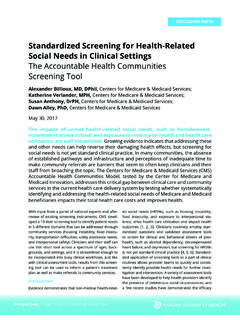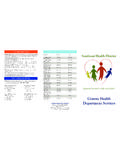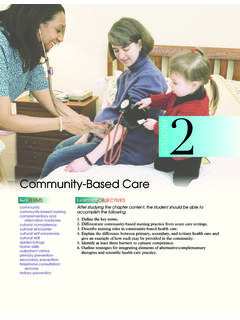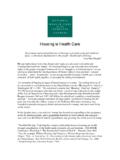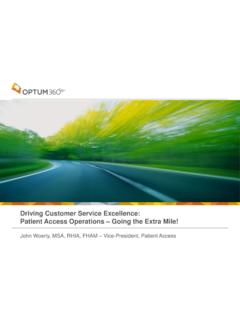Transcription of So You Want to Start a Health Center…?
1 So You Want to Start a Health Practical Guide for Starting a Federally Qualified Health CenterRevised July 2011 This publication was supported by Grant/Cooperative Agreement No. U30CS00209 from the Health Resources and Services Administration, Bureau of Primary Health Care (HRSA/BPHC). Its contents are solely the responsibility of the authors and do not necessarily represent the of-ficial views of Wisconsin Avenue, Suite 210 Bethesda, MD 20814 Phone you have any questions, feel free to contact: Pamela The National Association of community Health Centers wishes to acknowledge the following for their contributions to this guide:Authors of the original 1996 edition Tom Trompeter and Jennifer BrightBob Peoples and Suzanne Rossel of community Health Associates, Inc. for updatesPamela Byrnes and Freda Mitchem of the National Association of community Health Centers for input and edits in the 2005 revisionJudith Shea, Pamela Byrnes and Jaime Hirschfeld for the 2011 revisionsAnd to all of the people of the Health center Movement whose daily experiences contributed immeasurably to the information hereinA Practical Guide for Starting a Federally Qualified Health CenterNational Association of community Health Centers iTable of ContentsHelpful Acronyms.
2 I Health center Basics A. Federally Qualified Health Centers ..2 B. Medically Underserved Areas and C. Other Relevant D. Other Programs that Support Health Centers ..4 E. Strategic Considerations: Before Deciding to II Ensuring Broad community Support and Investment A. Defining B. community C. community Participation ..13 D. Involving the Provider community .. 14 Chapter III Needs Assessment and Planning A. Participating in Statewide Planning B. Identifying The Target Population(s)..17 C. Access to Estimating Need ..20 Assessing Available Resources ..21 D. Setting Priorities and E. Securing the Appropriate Federal Designations ..24 Chapter IV Looking for a Home (Organizationally and Physically) A. Organizational Non-Profit Public Entity Models.
3 29 B. Location ..30 C. Space Considerations ..30 Chapter V Developing community Governance A. Governance Requirements ..32 Roles and Responsibilities ..33 Board Board Legal Issues ..36A Practical Guide for Starting a Federally Qualified Health CenterNational Association of community Health Centers iiChapter VI Human Resources A. Staffing Needs .. 37 B. Hiring, Employing and Terminating Staff ..38 C. Recruiting and Retaining VII Business Planning A. Why Develop a Business B. Business Plan The Purpose ..41 The Market and The Business Strategy ..43 Management and Financial Documented Assumptions ..44 Implementation Plan ..62 Contingency Plan ..62 Chapter VIII Before You Open Your Doors: Insurance ..63 Chapter IX Information Technology/Data Systems.
4 65 Chapter X Conclusions and Final Recommendations A. Planning with Standards in Mind ..67 B. Where to Go for XI Resources and Websites ..71 List of Tables:Table 1 Sample community Analysis Outline ..11 Table 2 Sources of Demographic and Health Status Information ..19 Table 3 Sources of Information on Access to Health Care ..20 Table 4 Select National Averages: Health Resources 5 Physician FTE Conversions ..23 Table 6 Population Distribution Market Share 7 Total Market Share 8 Encounters per Year (1999)..45 Table 9 Market Share of Visits Example ..45 Table 10 Staff/Volume/Cost 11 Other Expense and Total Expense ..50 Table 12 FFS and Cost-based Revenue Detail Worksheet .. 54 Table 13 Capitation Revenue Detail 58 Table 14 Checklist ..69A Practical Guide for Starting a Federally Qualified Health CenterNational Association of community Health Centers iiiNational Association of community Health Centers Commonly Used Acronyms in The Health center IndustryADA Americans with Disabilities ActAHRQ Agency for Healthcare Research and QualityBBA Balanced Budget Act BHPr Bureau of Health ProfessionsBPHC Bureau of Primary Health CareCDC Centers for Disease ControlCHIP Children s Health Insurance ProgramCMS Centers for Medicare & Medicaid Services (Formerly Health Care Financing Administration)
5 DHHS Department of Health and Human ServicesFQHC Federally Qualified Health CenterFLSA Fair Labor Standards ActFTCA Federal Tort Claims ActGME Graduate Medical EducationHCPC Code Health Care Financing Administration Common Procedure Coding SystemHIPAA Health Insurance Portability and Accountability ActHMO Health Maintenance OrganizationHPSA Health Professions Shortage AreaHRSA Health Resources Services AdministrationISDI Integrated Service Delivery InitiativeISDN Integrated Services Delivery Network JCAHO Joint Commission Formerly Joint Commission on Accreditation of Healthcare OrganizationsMCH Maternal and Child HealthMCO Managed Care OrganizationMSO Management Service OrganizationMUA Medically Underserved AreaMUP Medically Underserved PopulationNHSC National Health Service CorpsOIG Office of Inspector GeneralOPA Office of Pharmacy AffairsORO Office of Regional OperationsPACE Program of All-Inclusive Care for the ElderlyPCA Primary Care AssociationPCMH Patient-Centered Medical HomePCO Primary Care OfficePDPA Prescription Drug Purchase Assistance ProgramPHS Public Health ServicePSO Provider Sponsored OrganizationRHC Rural Health ClinicROR Reach Out and ReadSCHIP State Child Health Insurance ProgramUDS Uniform Data SystemUSAID United States Agency for International DevelopmentWIC Women, Infants, and Children ProgramChapter I Health center BasicsNational Association of community Health Centers ivForewordThere is no one true path to establishing a successful Health center1.
6 Some Health centers function without ever obtaining federal funds or choose to pursue federal funding only after several years of operations. Sometimes existing organizations such as family planning clinics or Health departments begin gradually offering more comprehensive primary care services and develop into Health centers over a period of time. There are also communities that create new nonprofit organizations and apply for new Start federal Section 330 community Health center grant funding. This Guide is intended to be applicable under any of these to pursue a Health center and which option is right for a particular community will depend on many practical considerations. These include: T he needs in the community ( Health status, barriers and access issues); T he level of support (or resistance) likely to be found in the community and the approaches that will garner the most community support; T he ability to develop and nurture the community governance that will be necessary for success; W hether there are existing resources (organizations and people) in the community that will help and with whom a service delivery coalition might be formed; W hether the community has or could qualify for federal shortage designations; T he mix of financing options that make the most sense for the Health center .
7 T he amount of effort that will have to be expended to accomplish the necessary tasks for starting a Health undertaking an effort such as starting a Health center may seem a daunting task it will be important for planners to break things down into more manageable parts. This Guide is intended to provide stepbystep directions for planning and implementing a new Health center , including instructions on applying for federal designations and funding. Organizations that are currently providing some primary care services and are interested in developing a more comprehensive program that meets the Public Health Service Act, Section 330 requirements will also find the Guide very useful. First, a brief introduction to some of the key aspects of Health centers and some federal programs and desig-nations that are associated with them is provided.
8 Many of these topics will be discussed in greater detail in later sections. Throughout links to critical resources are as you approach deciding whether or not to embark on starting a Health center , there truly is no one way or one size fits all model. The essence of a Health center is that it grows out of, responds to, and is owned by the community it serves. While it is necessary to meet federal statutory requirements and program expectations, each Health center will take on the form that works best in its own setting. As we say in the Health center movement, if you have seen one Health center you have seen one Health center !1 T hroughout this monograph the term Health center is used denote a Federally Qualified Health center (FQHC) including community Health cen-ters, migrant Health centers, homeless Health centers and public housing primary care I Health center BasicsNational Association of community Health Centers 1 Chapter I Health center BasicsHealth centers play a vital role in the delivery of Health services to medically underserved people throughout the United States.
9 These organizations are primarily Public Health Service Act Section 330 grantees including: community Health Centers, Migrant Health Centers, Health Care for the Homeless Programs, and Public Housing Primary Care Programs. These community -based safety net providers are also commonly referred to as Federally Qualified Health Centers (FQHCs) because they meet rigorous governance, quality of care, service, and cost standards, and they are qualified to receive enhanced reimbursement under Medicaid and Medicare law. Health centers that receive federal funding do so under Section 330 of the Public Health Service Act through grants admin-istered by the Department of Health and Human Services, Health Resources and Services Administra-tion (HRSA), Bureau of Primary Health Care (BPHC). Health centers that meet federal FQHC statutes and program expectations but do not receive federal Section 330 funds can be designated as FQHC Look-Alikes.
10 These centers do have access to certain FQHC benefits (see discussion below).There are more than 1,200 community -based Health centers in operation today. Collectively, as of 2010, these centers serve as a Health care safety net for some 23 million patients (over million of whom are uninsured) through over 8,000 delivery sites in urban and rural underserved communities in all fifty states, the District of Columbia, Puerto Rico, Guam, Micronesia and the U. S. Virgin Without Health centers millions of people who are publicly insured (Medicaid; State Children s Health Insurance Program), uninsured and low income would have limited access to preventive and primary Health care. At the same time these Health centers produce demonstrated quality Health results at costs well below the national a result of recent Congressional and Presidential support, now tempered by budget constraints, there are limited opportunities for communities to develop new Health centers and to expand capacity and services at existing Health centers.

